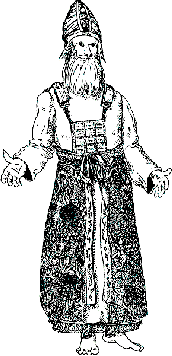Weekly Daf #112
Zevachim 86-92 -- Issue #112
12-18 Nissan 5756 / 1-7 April 1996
Clothes Help Make the Man
 Why did the Torah place the laws of the sacrifices (Vayikra
6-7) right next to the sacred garments worn by the kohanim
(Vayikra 8)?
Why did the Torah place the laws of the sacrifices (Vayikra
6-7) right next to the sacred garments worn by the kohanim
(Vayikra 8)?
To teach you that just as sacrifices serve as atonement for sin so do the garments of the kohanim serve as atonement.
Clothes exercise a disciplinary influence on their wearer. The Hebrew words for clothes and for character traits both stem from midah, suggesting a strong relationship between the attire of the soul and that of the body. Since the kohen had to be on a high spiritual level in order to perform the sacred service in the sanctuary he was required to wear special garments which would help him control his natural passions.
Our Sages offered a detailed description how each of the eight garments of the kohanim atoned - or controlled - another of the human drives. We shall content ourselves with just two examples.
The special hat worn by the kohen was to atone for haughtiness.
This can best be understood in light of the directive given by
our Sages to cover our heads in order to have a sense of awe for
our Master. The awareness of a power above stimulated by a head
covering is a universal need for all men but is even more important
in regard to a kohen, requiring him to have a special hat.
Since a Kohen Gadol had even a higher status of
holiness his hat was an even more elaborate one, and he also wore
a special plate inscribed with the name of Hashem on his forehead
to atone for any trace of brazenness which could arise from even
a momentary lapse of awareness that he stood in Hashem's presence.
The Royal Table
The flesh of the sacrifices which the Torah awarded to the kohanim may be eaten by them in any manner they choose, boiled or broiled, and with any variety of seasoning. This liberty to select the manner of preparing the food is based on the language used (Bamidbar 18:8) by the Torah in regard to these gifts which indicates that they were intended to enhance the status of the kohanim who must therefore be privileged to eat them in the manner of kings.
This can be better appreciated when we recall the observation made by our commentaries that in bringing a sacrifice the sinner must view it as a vicarious offering of himself, since he deserves to be destroyed for his wrongdoing but has been spared by the grace of Hashem. A part of this exercise in spiritually and psychologically cleansing himself from the impact of his sin is the awareness that the flesh of the sacrifice will be consumed by the kohanim who will pray for his rehabilitation.
It may be suggested that the royal fashion in which the kohanim
are permitted to eat this flesh facilitates this awareness that
he is dependent on these righteous servants of Hashem to pray
for the completion of his atonement.
General Editor: Rabbi Moshe Newman
Production Design: Lev Seltzer
HTML Design: Michael Treblow
© 1995 Ohr Somayach International - All rights reserved. This publication may be distributed to another person intact without prior permission. We also encourage you to include this material in other publications, such as synagogue newsletters. However, we ask that you contact us beforehand for permission, and then send us a sample issue.
This publication is available via E-Mail
Ohr Somayach Institutions is an international network of Yeshivot and outreach centers, with branches in North America, Europe, South Africa and South America. The Central Campus in Jerusalem provides a full range of educational services for over 685 full-time students. The Jewish Learning Exchange (JLE) of Ohr Somayach offers summer and winter programs in Israel that attract hundreds of university students from around the world for 3 to 8 weeks of study and touring.
 Copyright © 1995 Ohr Somayach International. Send us feedback.
Copyright © 1995 Ohr Somayach International. Send us feedback.Dedication opportunities are available for Weekly Daf. Please contact us for details.







